| Revision as of 21:18, 2 February 2020 view source2601:247:300:1fe0:cd1f:d508:4f59:f3a0 (talk) →Human diversTags: references removed Visual edit← Previous edit | Revision as of 21:20, 2 February 2020 view source El C (talk | contribs)Autopatrolled, Administrators183,806 editsm Reverted edits by 2601:247:300:1FE0:CD1F:D508:4F59:F3A0 (talk) to last version by IdreamofJeanieTag: RollbackNext edit → | ||
| Line 205: | Line 205: | ||
| == Human divers == | == Human divers == | ||
| The ] are Japanese skin divers, predominantly women, who traditionally dive for shellfish and seaweed wearing only a loincloth and who have been in action for at least 2,000 years. Starting in the twentieth century, they have increasingly been regarded as a tourist attraction.<ref>{{cite journal| title = Physiology of Breath-Hold Diving and the Ama of Japan| date = 1 September 1965| volume = Publication 1341| accessdate = 26 July 2012| editor1-first = Herrman| editor1-last = Rahn| pages = 25, 41| publisher = US National Research Council| url = http://archive.rubicon-foundation.org/xmlui/handle/123456789/3279| journal = | archive-url = https://web.archive.org/web/20120807051328/http://archive.rubicon-foundation.org/xmlui/handle/123456789/3279| archive-date = 7 August 2012| url-status = dead}}</ref> They operate off reefs near the shore, and some perform for sightseers instead of diving to collect a harvest. They have been romanticized as mermaids.<ref>{{cite book|last= Stott|first= Rebecca|title= Oyster|year= 2004 | publisher = Reaktion Books|location=London|isbn=978-1-86189-221-8|page=194|url= https://books.google.com/books?id=3qx2ELi_roMC&lpg=PA194}}</ref> | |||
| ⚫ | .<ref name="wired1">{{cite magazine|last=Schiller |first= Jakob |url = https://www.wired.com/rawfile/2012/04/professional-mermaids-are-lost-treasure-of-florida-park/ |title=Professional Mermaids Are Lost Treasure of Florida Park | magazine = Wired |date=2012-04-20 |accessdate=2012-07-26}}</ref> Most of the current performers work part-time while attending college, and all are certified ] divers. They wear fabric tails and perform aquatic ballet (while holding their breath) for an audience in an underwater stage with glass walls. Children often ask if the "mermaids" are real. The park's PR director says "Just like with ] or any other mythical character, we always say yes. We're not going to tell them they're not real".<ref>{{cite web|last=Abbey |first=Melissa |url=http://articles.cnn.com/2012-07-05/us/us_mermaids-noaa_1_weeki-wachee-springs-noaa-atmospheric-administration?_s=PM:US |title=Mermaids don't exist... or do they? |publisher=CNN |date=2012-07-05 |accessdate=2012-07-26 |url-status=dead |archiveurl=https://web.archive.org/web/20120725164446/http://articles.cnn.com/2012-07-05/us/us_mermaids-noaa_1_weeki-wachee-springs-noaa-atmospheric-administration?_s=PM%3AUS |archivedate=2012-07-25 }}</ref> | ||
| ⚫ | Professional female divers have performed as mermaids at Florida's ] since 1947. The state park calls itself "The Only City of Live Mermaids"<ref>{{cite news | last = Connolly | first = Kevin P. | url = http://articles.orlandosentinel.com/2012-07-05/news/os-florida-mermaids-weeki-wachee-20120705_1_mermaids-website-atmospheric-administration |title=Florida mermaids not real: Weeki Wachee mermaids, other 'aquatic humanoids' are unreal, feds say |newspaper=Orlando Sentinel |date=2012-07-05 |accessdate = 2012-07-26}}</ref> and was extremely popular in the 1960s, drawing almost one million tourists per year.<ref name = "wired1">{{cite magazine|last=Schiller |first= Jakob |url = https://www.wired.com/rawfile/2012/04/professional-mermaids-are-lost-treasure-of-florida-park/ |title=Professional Mermaids Are Lost Treasure of Florida Park | magazine = Wired |date=2012-04-20 |accessdate=2012-07-26}}</ref> Most of the current performers work part-time while attending college, and all are certified ] divers. They wear fabric tails and perform aquatic ballet (while holding their breath) for an audience in an underwater stage with glass walls. Children often ask if the "mermaids" are real. The park's PR director says "Just like with ] or any other mythical character, we always say yes. We're not going to tell them they're not real".<ref>{{cite web|last=Abbey |first=Melissa |url=http://articles.cnn.com/2012-07-05/us/us_mermaids-noaa_1_weeki-wachee-springs-noaa-atmospheric-administration?_s=PM:US |title=Mermaids don't exist... or do they? |publisher=CNN |date=2012-07-05 |accessdate=2012-07-26 |url-status=dead |archiveurl=https://web.archive.org/web/20120725164446/http://articles.cnn.com/2012-07-05/us/us_mermaids-noaa_1_weeki-wachee-springs-noaa-atmospheric-administration?_s=PM%3AUS |archivedate=2012-07-25 }}</ref> | ||
| == Gallery == | == Gallery == | ||
Revision as of 21:20, 2 February 2020
This article is about fish-bodied female merfolk. For the males, see merman. For the people, see merfolk. For other uses, see Mermaid (disambiguation). Legendary aquatic creature with an upper body in human female form
 | |
| Grouping | Mythological |
|---|---|
| Sub grouping | Water spirit |
| Country | Worldwide |
| Habitat | Ocean, sea |
In folklore, a mermaid is an aquatic creature with the head and upper body of a female human and the tail of a fish. Mermaids appear in the folklore of many cultures worldwide, including the Near East, Europe, Asia, and Africa.
In ancient Assyria the goddess Atargatis transformed herself into a mermaid out of shame for accidentally killing her human lover. Mermaids are sometimes associated with perilous events such as floods, storms, shipwrecks, and drownings. In other folk traditions (or sometimes within the same tradition), they can be benevolent or beneficent, bestowing boons or falling in love with humans.
The male equivalent of the mermaid is the merman, also a familiar figure in folklore and heraldry. Although traditions about and sightings of mermen are less common than those of mermaids, they are generally assumed to co-exist with their female counterparts. The male and the female collectively are sometimes referred to as merfolk or merpeople.
The conception of mermaids in the West may have been influenced by the Sirens of Greek mythology, which were originally half-birdlike, but came to be pictured as half-fishlike in the Christian era. Historical accounts of mermaids, such as those reported by Christopher Columbus during his exploration of the Caribbean, may have been sightings of manatees or similar aquatic mammals. While there is no evidence that mermaids exist outside folklore, reports of mermaid sightings continue to the present day.
Mermaids have been a popular subject of art and literature in recent centuries, such as in Hans Christian Andersen's literary fairy tale "The Little Mermaid" (1836). They have subsequently been depicted in operas, paintings, books, comics, animation, and live action films.
Etymology
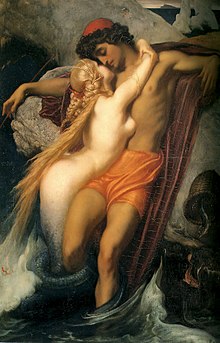
The word mermaid is a compound of the Old English mere (sea), and maid (a girl or young woman). The equivalent term in Old English was merewif. They are conventionally depicted as beautiful with long flowing hair.
Origins
The sirens of Greek mythology (especially the Odyssey), conceived of as half-bird and half-woman, gradually shifted to the image of a fish-tailed woman. This shift possibly started as early as the Hellenistic Period, but is clearly evident in mermaid-like depictions of "sirens" in later Christian bestiaries.
Some attributes of Homer's sirens, such as the enticement of men and their beautiful song, also became attached to the mermaid.
There are also naturalist theories on the origins of the mermaid, postulating they derive from sightings of the manatee, or dugong or even seals.
Folklore and mythography
Mesopotamia and Eastern Mediterranean
Depictions of entities with the tails of fish, but upper bodies of human beings appear in Mesopotamian artwork from the Old Babylonian Period onwards. These figures are usually mermen, but mermaids do occasionally appear. The name for the mermaid figure may have been kuliltu, meaning "fish-woman". Such figures were used in Neo-Assyrian art as protective figures and were shown in both monumental sculpture and in small, protective figurines.

The first known mermaid stories appeared in Assyria c. 1000 BC. The goddess Atargatis, mother of Assyrian queen Semiramis, loved a mortal (a shepherd) and unintentionally killed him. Ashamed, she jumped into a lake and took the form of a fish, but the waters would not conceal her divine beauty. Thereafter, she took the form of a mermaid—human above the waist, fish below—although the earliest representations of Atargatis showed her as a fish with a human head and arm, similar to the Babylonian god Ea. The Greeks recognized Atargatis under the name Derketo. Sometime before 546 BC, Milesian philosopher Anaximander postulated that mankind had sprung from an aquatic animal species. He thought that humans, who begin life with prolonged infancy, could not have survived otherwise.
There is a mermaid legend attached around the sister of Alexander the Great, but that legend is of modern mintage (see below). In the second century AD, the Hellenized Syrian writer Lucian of Samosata wrote about the Syrian temples he had visited in his treatise On the Syrian Goddess, which was originally written in Ionic Greek:
Among them – Now that is the traditional story among them concerning the temple. But other men swear that Semiramis of Babylonia, whose deeds are many in Asia, also founded this site, and not for Hera but for her own mother, whose name was Derketo. I saw Derketo's likeness in Phoenicia, a strange marvel. It is woman for half its length; but the other half, from thighs to feet, stretched out in a fish's tail. But the image in the Holy City is entirely a woman, and the grounds for their account are not very clear. They consider fish to be sacred, and they never eat them; and though they eat all other fowls they do not eat the dove, for they believe it is holy. And these things are done, they believe, because of Derketo and Semiramis, the first because Derketo has the shape of a fish, and the other because ultimately Semiramis turned into a dove. Well, I may grant that the temple was a work of Semiramis perhaps; but that it belongs to Derketo I do not believe in any way. For among the Egyptians some people do not eat fish, and that is not done to honor Derketo.
In his Natural History 9.4.9–11, Pliny the Elder describes numerous sightings of mermaids off the coast of Gaul, noting that their bodies were covered all over in scales and that their corpses frequently washed up on shore. He comments that the governor of Gaul even wrote a letter to Emperor Augustus to inform him.
One Thousand and One Nights
The One Thousand and One Nights collection includes several tales featuring "sea people", such as "Jullanâr the Sea-born and Her Son King Badr Bâsim of Persia". Unlike depictions of mermaids in other mythologies, these are anatomically identical to land-bound humans, differing only in their ability to breathe and live underwater. They can (and do) interbreed with land humans, and the children of such unions have the ability to live underwater. In the tale "Abdullah the Fisherman and Abdullah the Merman", the protagonist Abdullah the Fisherman gains the ability to breathe underwater and discovers an underwater society that is portrayed as an inverted reflection of society on land. The underwater society follows a form of primitive communism where concepts like money and clothing do not exist. In "The Adventures of Bulukiya", the protagonist Bulukiya's quest for the herb of immortality leads him to explore the seas, where he encounters societies of mermaids.
Britain and Ireland
For more on the Irish mermaid, see merrow.The Norman chapel in Durham Castle, built around 1078 by Saxon stonemasons, has what is probably the earliest surviving artistic depiction of a mermaid in England. It can be seen on a south-facing capital above one of the original Norman stone pillars.
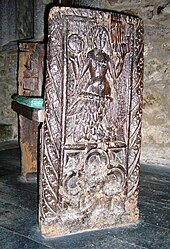
Mermaids appear in British folklore as unlucky omens, both foretelling disaster and provoking it. Several variants of the ballad Sir Patrick Spens depict a mermaid speaking to the doomed ships. In some versions, she tells them they will never see land again; in others, she claims they are near shore, which they are wise enough to know means the same thing. Mermaids can also be a sign of approaching rough weather, and some have been described as monstrous in size, up to 2,000 feet (610 m).
Mermaids have also been described as able to swim up rivers to freshwater lakes. In one story, the Laird of Lorntie went to aid a woman he thought was drowning in a lake near his house; a servant of his pulled him back, warning that it was a mermaid, and the mermaid screamed at them that she would have killed him if it were not for his servant. But mermaids could occasionally be more beneficent; e.g., teaching humans cures for certain diseases. Mermen have been described as wilder and uglier than mermaids, with little interest in humans.
According to legend, a mermaid came to the Cornish village of Zennor where she used to listen to the singing of a chorister, Matthew Trewhella. The two fell in love, and Matthew went with the mermaid to her home at Pendour Cove. On summer nights, the lovers can be heard singing together. At the Church of Saint Senara in Zennor, there is a famous chair decorated by a mermaid carving which is probably six hundred years old.
Some tales raised the question of whether mermaids had immortal souls, answering in the negative.
In Irish lore, the figure of Lí Ban appears as a sanctified mermaid, but she was a human being transformed into a mermaid. After three centuries, when Christianity had come to Ireland, she was baptized. The Irish mermaid is called merrow in tales such as "Lady of Gollerus" published in the 19th century. In Scottish mythology, a ceasg is a fresh-water mermaid, though little beside the term has been preserved in folklore.
Mermaids from the Isle of Man, known as ben-varrey, are considered more favorable toward humans than those of other regions, with various accounts of assistance, gifts and rewards. One story tells of a fisherman who carried a stranded mermaid back into the sea and was rewarded with the location of treasure. Another recounts the tale of a baby mermaid who stole a doll from a human little girl, but was rebuked by her mother and sent back to the girl with a gift of a pearl necklace to atone for the theft. A third story tells of a fishing family that made regular gifts of apples to a mermaid and was rewarded with prosperity.
Western Europe

A freshwater mermaid-like creature from European folklore is Melusine. She is sometimes depicted with two fish tails, or with the lower body of a serpent.
The alchemist Paracelsus's treatise Liber de Nymphis (1566) spawned the idea that the water elemental (or water sprite) could acquire an immortal soul through marriage with a human; this led to the writing of De la Motte Fouqué's novella Undine, and eventually to the most famous literary mermaid tale of all, Hans Christian Andersen's fairy tale, The Little Mermaid".
A world-famous statue of the Little Mermaid, based on Andersen's fairy tale, has been in Copenhagen, Denmark since August 1913, with copies in 13 other locations around the world – almost half of them in North America.
Byzantine and Ottoman Greece
The conception of the siren as both a mermaid-like creature and part bird-like persisted in Byzantine Greece for some time. The Physiologus began switching the illustration of the siren as that a mermaid, as in a version dated to the 9th century. Whereas the 10th century Byzantine Greek dictionary Suda still favored the avian description.
Therei is a modern Greek legend that Alexander the Great's sister Thessalonike did not die and turned into a mermaid (Template:Lang-el) after her death, living in the Aegean. She would ask the sailors on any ship she would encounter only one question: "Is King Alexander alive?" (Template:Lang-el;"), to which the correct answer was: "He lives and reigns and conquers the world" (Greek: "Ζει και βασιλεύει και τον κόσμον κυριεύει"). This answer would please her, and she would accordingly calm the waters and bid the ship farewell. Any other answer would enrage her, and she would stir up a terrible storm, dooming the ship and every sailor on board. This legend derives from an Alexander Romance entitled the Phylláda tou Megaléxandrou (Φυλλάδα του Μεγαλέξανδρου) dating to the Ottoman Greece period, first printed in 1680.
Eastern Europe
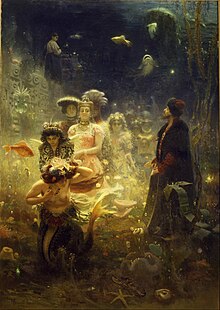
Rusalkas are the Slavic counterpart of the Greek sirens and naiads. The nature of rusalkas varies among folk traditions, but according to ethnologist D.K. Zelenin they all share a common element: they are the restless spirits of the unclean dead. They are usually the ghosts of young women who died a violent or untimely death, perhaps by murder or suicide, before their wedding and especially by drowning. Rusalkas are said to inhabit lakes and rivers. They appear as beautiful young women with long pale green hair and pale skin, suggesting a connection with floating weeds and days spent underwater in faint sunlight. They can be seen after dark, dancing together under the moon and calling out to young men by name, luring them to the water and drowning them. The characterization of rusalkas as both desirable and treacherous is prevalent in Russia, Ukraine and Belarus, and was emphasized by 19th-century Russian authors. The best-known of the great Czech nationalist composer Antonín Dvořák's operas is Rusalka.
In Sadko (Template:Lang-ru), an East Slavic epic, the title character—an adventurer, merchant, and gusli musician from Novgorod—lives for some time in the underwater court of the "Sea Tsar" and marries his daughter, Chernava, before finally returning home. The tale inspired such works as the poem "Sadko" by Alexei Tolstoy (1817–75), the opera Sadko composed by Nikolai Rimsky-Korsakov, and the painting by Ilya Repin.
China
Further information: Merfolk § ChinaMerfolk are mentioned in the Shanhaijing (Classic of Mountains and Seas) compilation of Chinese geography and mythology, dating from the 4th century BC.
The jiaoren (鮫人) or "shark people" are mentioned in the Bowuzhi (c. 290 CE); and a number of other texts, including the Shuyi ji [zh] "Records of Strange Things" (early 6th century CE).
Sightings in China
The Yuezhong jianwen (Wade–Giles: Yueh-chung-chieh-wen; the "Seens and Heards", or "Jottings on the South of China", 1730) contains two accounts concerning mermaids. In the first, a man captures a mermaid (海女 "sea woman") on the shore of Lantau Island (Wade–Giles: Taiyü-shan). She looks human in every respect except that her body is covered with fine hair of many colors. She can't talk, but he takes her home and marries her. After his death, the mermaid returns to the sea where she was found. In the second story, a man sees a woman lying on the beach while his ship was anchored offshore. On closer inspection, her feet and hands appear to be webbed. She is carried to the water, and expresses her gratitude toward the sailors before swimming away.
Korea
Korea is bounded on three sides by the sea. In some villages near the sea in Korea, there are mysterious stories about mermaids. Mermaids have features just like humans. Kim Dam Ryeong, who was a mayor of the town, saved four captured mermaids from a fisherman, as recorded in the Eou yadam (unofficial histories). In Dongabaek Island of Busan, there's a tale of Princess Hwang-ok from the kingdom of Naranda, a mythical undersea kingdom of mermaids; this tale is based on the historical Heo Hwang-ok from India. Another tale concerns a mermaid named Sinjike (Template:Lang-ko) who warned fishermen of impending storms by singing and throwing rocks into the sea from Geomun Island. The island's residents believed her to be goddess of the sea and that she could predict the weather.
Japan
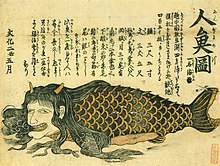
The Japanese ningyo (人魚, literally "human-fish") is glossed as a being that is usually part human female and part fish.
- Without a human torso
In certain prominent depictions, the ningyo is not quite half-female, but has a human female head resting on a fish-like body. An example is shown right, published in a kawaraban [ja] news flier dated 5th month of Bunka 2 (1805). It was said to have a pair of golden horns, a red belly, three eyes on each side of its torso, and a carp-like tail end. This mermaid purportedly measured 3 jō 5 shaku or 10.6 metres (35 ft) and required 450 rifles to take down. The place of capture was Yokata-ura, in what is now Toyama Bay.
- As yōkai
A ningyo might be counted as a yōkai since it is included in Toriyama Sekien's Hyakki Yagyō series. A particular gender is not clear here, as it is only given as a being with "a human face, a fish body", and Sekien equates the nigyo to the Di peiople or Diren [zh], which are described in the Classic of Mountains and Seas and translated as the Low People".
- Yaobikuni
A famous ningyo legend concerns the Yaobikuni (八百比丘尼) who is said to have partaken of the flesh of a merfolk and attained miraculous longevity and lived for centuries. It is not discernible whether the flesh was a female; a pair of translators call it a "flesh of a mermaid" in one book, but merely a "strange fish with a human face" in another.
Hinduism
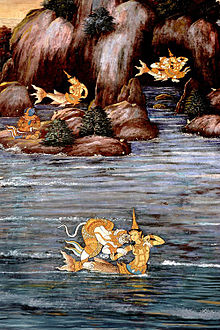
Suvannamaccha (lit. golden mermaid) is a daughter of Ravana that appears in the Cambodian and Thai versions of the Ramayana. She is a mermaid princess who tries to spoil Hanuman's plans to build a bridge to Lanka but falls in love with him instead. She is a popular figure of Thai folklore.
Africa
Mami Water (Lit. "Mother of the Water") are water spirits venerated in west, central and southern Africa, and in the African diaspora in the Caribbean and parts of North and South America. They are usually female, but are sometimes male. They are regarded as diabolical beings, and are often femme fatale, luring men to their deaths. The Persian word "برایم بمان" or "maneli" means "mermaid".
In Zimbabwe mermaids are known as "njuzu". They are believed to be solitary and occupy one body of water. Individual njuzu may be benevolent or malicious. Angry njuzu may be blamed for unexpected misfortunes, such as bad weather, or the sudden disappearance of people. Benevolent njuzu are thought to reside in peaceful lakes or rivers. If a person goes missing near such lakes or rivers, he or she may have been taken by the njuzu. To obtain the person's release, local elders will brew beer as a propitiatory offering, and ask the njuzu to return the person alive. Those seeking the person's release are not supposed to cry or shed tears. If the njuzu releases the person, he or she will become, or be regarded as a n'anga, or traditional healer, with knowledge of herbs, medicinal plants, and cures.
Other
The Neo-Taíno nations of the Caribbean identify a mermaid called Aycayia with attributes of the goddess Jagua and the hibiscus flower of the majagua tree Hibiscus tiliaceus. In modern Caribbean culture, there is a mermaid recognized as a Haitian vodou loa called La Sirene (lit. "the mermaid"), representing wealth, beauty and the orisha Yemaya.
Examples from other cultures are the jengu of Cameroon, the iara of Brazil and the Greek oceanids, nereids and naiads. The ningyo is a fishlike creature from Japanese folklore, and consuming its flesh bestows amazing longevity. Mermaids and mermen are also characters of Philippine folklore, where they are locally known as sirena and siyokoy respectively. The Javanese people believe that the southern beach in Java is a home of Javanese mermaid queen Nyi Roro Kidul. The myth of "Pania of the Reef", a well known tale of Māori mythology, has many parallels with stories of sea-people in other parts of the world.
According to Dorothy Dinnerstein's book The Mermaid and the Minotaur, human-animal hybrids such as mermaids and minotaurs convey the emergent understanding of the ancients that human beings were both one with and different from animals:
nature is internally inconsistent, that our continuities with, and our differences from, the earth's other animals are mysterious and profound; and in these continuities, and these differences, lie both a sense of strangeness on earth and the possible key to a way of feeling at home here."
Reported sightings
In 1493, sailing off the coast of Hispaniola, Christopher Columbus spotted three sirens or mermaids (Template:Lang-es) which he said were not as beautiful as they are represented, due to some masculine features in their faces, but these are considered to be sightings of manatees.
During Henry Hudson's second voyage, on June 15, 1608, members of his crew reported sighting a mermaid in the Arctic Ocean, either in the Norwegian or Barents Seas. As well, the logbook of Blackbeard, an English pirate, records that he instructed his crew on several voyages to steer away from charted waters which he called ‘enchanted’ for fear of merfolk or mermaids, which Blackbeard himself and members of his crew reported seeing. These sightings were often recounted and shared by sailors and pirates who believed that mermaids brought bad luck and would bewitch them into giving up their gold and dragging them to the bottom of the sea. Two sightings were reported in Canada near Vancouver and Victoria, one from sometime between 1870 and 1890, the other from 1967. A Pennsylvania fisherman reported five sightings of a mermaid in the Susquehanna River near Marietta in June 1881.
In August 2009, after dozens of people reported seeing a mermaid leaping out of Haifa Bay waters and doing aerial tricks, the Israeli coastal town of Kiryat Yam offered a $1 million award for proof of its existence. In February 2012, work on two reservoirs near Gokwe and Mutare in Zimbabwe stopped when workers refused to continue, stating that mermaids had hounded them away from the sites. It was reported by Samuel Sipepa Nkomo, the water resources minister.
Hoaxes and show exhibitions

A celebrated example of mermaid hoax was the Feejee mermaid exhibited in London in 1822 and later in America by P. T. Barnum in 1842, in this case an investigator claims to have traced the mermaid's manufacture to a Japanese fisherman. Although billed as a "mermaid", this has also been bluntly referred to as a "Barnum's merman" in one piece of journalism.
A similar fake "mermaid" at the Horniman Museum has also been reassessed by another curator as a "merman". DNA testing was inconclusive as to species (and nothing on gender was disclosed), but despite being catalogued as a "Japanese Monkey-fish", it was determined to contain no monkey parts, but only the teeth, scales, etc. of fish.
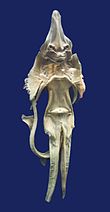
Fake mermaids made in China and the Malay archipelago out of monkey and fish parts were imported into Europe by Dutch traders since the mid-16th century, and their manufactures are thought to go back earlier. The equivalent industry in Europe was the Jenny Haniver made from dried rays.
In the middle of the 17th century, John Tradescant the elder created a wunderkammer (called Tradescant's Ark) in which he displayed, among other things, a "mermaid's hand".
Scientific inquiry
The topic of mermaids in earnest has arisen in several instances of scientific scrutiny, including a biological assessment of the unlikelihood of the supposed evolutionary biology of the mermaid on the popular marine science website, DeepSeaNews. Five of the primary reasons listed as to why mermaids don't fit current evolutionary understanding include: 1) thermoregulation (adaptations for regulating body heat), 2) evolutionary mismatch, 3) reproductive challenges, 4) digestive differences between mammals and fish, and 5) lack of physical evidence.
Mermaids were also discussed tongue-in-cheek in a scientific article by University of Washington emeritus oceanographer Karl Banse. His article was written as a parody, but mistaken as a true scientific exposé by believers as it was published in a scientific journal.
Arts, entertainment, and media
See also: Mermaids in popular culture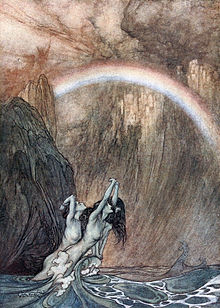
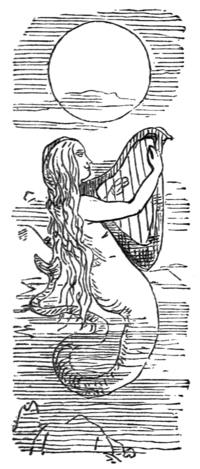
The best-known example of mermaids in literature is probably Hans Christian Andersen's fairy tale, The Little Mermaid, first published in 1837. The title character, youngest of the Merman-king's daughters, must wait her turn to reach the age when she will be allowed to emerge from the sea and sit on a rock, there to observe the upper world. The mermaid falls in love with a human prince, and also longs for an eternal soul like humans, despite the shorter life-span. The two cravings are intertwined: only by achieving true love will her soul bind with a human's and become everlasting. But the mermaid's fish-tail poses an insurmountable obstacle for enticing humans, and the sea-witch offers a potion to transform into human form, at a price (the mermaid's tongue and beautiful voice). The mermaid endures the excruciating pain of having human legs, and despite her inability to speak, almost succeeds in wedding the prince, but for a twist of fate. The mermaid is doomed unless she stabs the prince with a magic knife before his marriage. But she does not have the resolve and dies the mermaid way, dissolving into foam.
Andersen's works has been translated into over 100 languages. The mermaid (as conceived by Andersen) is similar to an Undine, a water nymph in German folklore who could only obtain an immortal soul by marrying a human being. Andersen's heroine inspired a bronze sculpture in Copenhagen harbour and influenced Western literary works such as Oscar Wilde's The Fisherman and His Soul and H.G. Wells' The Sea Lady. Sue Monk Kidd wrote a book called The Mermaid Chair loosely based on the legends of Saint Senara and the mermaid of Zennor.
Sculptures and statues of mermaids can be found in many countries and cultures, with over 130 public art mermaid statues across the world. Countries with public art mermaid sculptures include Russia, Finland, Lithuania, Poland, Romania, Denmark, Norway, England, Scotland, Ireland, Germany, Netherlands, Belgium, France, Spain, Italy, Austria, Switzerland, Greece, Turkey, India, China, Thailand, South Korea, Japan, Guam, Australia, New Zealand, Brazil, Ecuador, Colombia, Mexico, Cayman Islands, Mexico, Saudi Arabia (Jeddah), the United States (including Hawaii and Virgin Islands) and Canada. Some of these mermaid statues have become icons of their city or country, and have become major tourist attractions in themselves. The Little Mermaid statue in Copenhagen is an icon of that city as well as of Denmark. The Havis Amanda statue symbolizes the rebirth of the city of Helsinki, capital of Finland. The Syrenka (mermaid) is part of the Coat of Arms of Warsaw, and is considered a protector of Warsaw, capital of Poland, which publicly displays statues of their mermaid.
Musical depictions of mermaids include those by Felix Mendelssohn in his Fair Melusina overture and the three "Rhine daughters" in Richard Wagner's opera Der Ring des Nibelungen. Lorelei, the name of a Rhine mermaid immortalized in the Heinrich Heine poem of that name, has become a synonym for a siren. The Weeping Mermaid is an orchestral piece by Taiwanese composer Fan-Long Ko.
An influential image was created by John William Waterhouse, from 1895 to 1905, entitled A Mermaid. An example of late British Academy style artwork, the piece debuted to considerable acclaim (and secured Waterhouse's place as a member of the Royal Academy), but disappeared into a private collection and did not resurface until the 1970s. It is currently once again in the Royal Academy's collection. Mermaids were a favorite subject of John Reinhard Weguelin, a contemporary of Waterhouse. He painted an image of the mermaid of Zennor as well as several other depictions of mermaids in watercolour.
Film depictions include Miranda (1948), Night Tide (1961), the romantic comedy Splash (1984), and Aquamarine (2006). A 1963 episode of the television series Route 66 entitled "The Cruelest Sea" featured a mermaid performance artist working at Weeki Wachee aquatic park. Mermaids also appeared in the popular supernatural drama television series Charmed, and were the basis of its spin-off series Mermaid. In She Creature (2001), two carnival workers abduct a mermaid in Ireland c. 1900 and attempt to transport her to America. The film Pirates of the Caribbean: On Stranger Tides mixes old and new myths about mermaids: singing to sailors to lure them to their death, growing legs when taken onto dry land, and bestowing kisses with magical healing properties.
Disney's musical animated version of Andersen's tale, The Little Mermaid was released in 1989. Notable changes to the plot of Andersen's story include the religious aspects of the fairy tale, including the mermaid's quest to obtain an immortal soul. The sea-witch herself replaces the princess to whom the prince becomes engaged, using the mermaid's voice to prevent her from obtaining the prince's love. However, on their wedding day the plot is revealed, and the sea-witch is vanquished. The knife motif is not used in the film, which ends with the mermaid and the prince marrying.
Hayao Miyazaki's Ponyo is an animated film about a ningyo who wants to become a human girl with the help of her human friend Sosuke.
The Australian teen dramedy H2O: Just Add Water chronicles the adventures of three modern-day mermaids along the Gold Coast of Australia.
The Starbucks Coffee logo is either a 2 tailed siren , mermaid, or melusine.
Heraldry
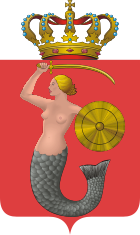
In heraldry, the charge of a mermaid is commonly represented with a comb and a mirror, and blazoned as a "mermaid in her vanity". In addition to vanity, mermaids are also a symbol of eloquence.
Mermaids appear with greater frequency as heraldic devices than mermen do. A mermaid appears on the arms of the University of Birmingham, in addition to those of several British families.
A mermaid with two tails is referred to as a melusine. Melusines appear in German heraldry, and less frequently in the British version.
A shield and sword-wielding mermaid (Syrenka) is on the official coat of arms of Warsaw. Images of a mermaid have symbolized Warsaw on its arms since the middle of the 14th century. Several legends associate Triton of Greek mythology with the city, which may have been the origin of the mermaid's association.
The Cusack family crest includes a mermaid wielding a sword, as depicted on a memorial stone for Sir Thomas Cusack (1490–1571).
The city of Norfolk, Virginia, also uses a mermaid as a symbol. The personal coat of arms of Michaëlle Jean, a former Governor General of Canada, features two mermaids as supporters.
Mermaid fandom
Interest in mermaid costuming has grown alongside the popularity of fantasy cosplay as well as the availability of inexpensive monofins used in the construction of mermaid costumes. These costumes are typically designed to be used while swimming, in an activity known as mermaiding. Mermaid fandom conventions have also been held.
Human divers
The Ama are Japanese skin divers, predominantly women, who traditionally dive for shellfish and seaweed wearing only a loincloth and who have been in action for at least 2,000 years. Starting in the twentieth century, they have increasingly been regarded as a tourist attraction. They operate off reefs near the shore, and some perform for sightseers instead of diving to collect a harvest. They have been romanticized as mermaids.
Professional female divers have performed as mermaids at Florida's Weeki Wachee Springs since 1947. The state park calls itself "The Only City of Live Mermaids" and was extremely popular in the 1960s, drawing almost one million tourists per year. Most of the current performers work part-time while attending college, and all are certified Scuba divers. They wear fabric tails and perform aquatic ballet (while holding their breath) for an audience in an underwater stage with glass walls. Children often ask if the "mermaids" are real. The park's PR director says "Just like with Santa Claus or any other mythical character, we always say yes. We're not going to tell them they're not real".
Gallery
-
 Mermaid carved on a capital of the Rio Mau Monastic church (1151).
Mermaid carved on a capital of the Rio Mau Monastic church (1151).
-
 A stone coat of arms in Santo Domingo church (Pontevedra, Galicia), 16th century.
A stone coat of arms in Santo Domingo church (Pontevedra, Galicia), 16th century.
-
 Mermaid in Fefiñans Manor house (Cambados, Galicia), 16th century.
Mermaid in Fefiñans Manor house (Cambados, Galicia), 16th century.
-
 'A most strange and true report of a monstrous fish' Illustration from an early printed report of a Mermaid sighting, 1604
'A most strange and true report of a monstrous fish' Illustration from an early printed report of a Mermaid sighting, 1604
-
English carved decoration by James Richards on Prince Frederick's Barge, 1731–1732
-
Portuguese Baroque stonework in Póvoa de Varzim Matriz Church (1743-1757)
-
Fountain depicting a mermaid playing a guitar, located in the Museum of the City of Mexico (17th century)
-
 A stone coat of arms in (Mugardos, Galicia), 18th century
A stone coat of arms in (Mugardos, Galicia), 18th century
-
 Illustration from Vanity Fair, Becky Sharp as a mermaid
Illustration from Vanity Fair, Becky Sharp as a mermaid
-
 Mermaid and merman, 1866. Unknown Russian folk artist
Mermaid and merman, 1866. Unknown Russian folk artist
-
 Havfrue, by Elisabeth Jerichau Baumann (1873)
Havfrue, by Elisabeth Jerichau Baumann (1873)
-
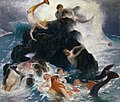 The Play of the Naiads, by Arnold Böcklin (1886)
The Play of the Naiads, by Arnold Böcklin (1886)
-
 The Land Baby, by John Collier (1899)
The Land Baby, by John Collier (1899)
-
 The Mermaid of Zennor by John Reinhard Weguelin (1900)
The Mermaid of Zennor by John Reinhard Weguelin (1900)
-
 The Mermaid, by Howard Pyle (1910)
The Mermaid, by Howard Pyle (1910)
-
 The Mermaid and the Satyr, by Ferdinand Leeke (1917)
The Mermaid and the Satyr, by Ferdinand Leeke (1917)
-
Mermaids, by Jean Francis Aubertin (circa 1920)
-
 The Little Mermaid's Sisters by Anne Anderson (circa 1910)
The Little Mermaid's Sisters by Anne Anderson (circa 1910)
-
 Illustration of The Little Mermaid by E. S. Hardy (circa 1890)
Illustration of The Little Mermaid by E. S. Hardy (circa 1890)
-
 The Little Mermaid statue in Copenhagen (1913)
The Little Mermaid statue in Copenhagen (1913)
-
 The mermaid of the Phra Aphai Mani legend in Songkhla, Thailand (2006)
The mermaid of the Phra Aphai Mani legend in Songkhla, Thailand (2006)
See also
- Ichthyosis
- Kelpie
- List of piscine and amphibian humanoids
- Melusine
- Merlion
- The Mermaid of Warsaw
- Merman
- Mythological hybrid
- Sea monster
- Sea witch
- Selkie
- Sirenia - an order of aquatic mammals that include manatees and dugongs.
- Sirenomelia - or "mermaid syndrome", a disorder in which a child is born with legs fused together.
- Undine
- Aquaria (video game)
Explanatory notes
- The earliest surviving manuscripts of the Greek bestiary or Physiologus from the 2nd century still depict the siren as a bird woman. But a 9th century bestiary as an example depicts the siren as mermaid. Sometimes the illustration is that of a mermaid while the text still described a bird-woman.
- A 15th-century compilation of quotations from Chinese literature, the Chengyu kao [zh] (Chinese: 成語考; "Idioms investigated") merely gives a partial quote from the Bowuzhi as "The mermaid wept tears that became pearls".
- Even though the flier itself reads "Yomo-no-ura, Hōjō-ga-fuchi, Etchū Province 越中国、放生淵四方浦", the correct reading is "Yokata-ura".
- The prince remains unacquainted with her, despite being saved by her from a shipwreck. The mermaid had used the ability to produce foam conceal herself.
- The prince is betrothed to a princess, who turns out to be the girl he mistakenly believed to be his rescuer (due to the mermaid's concealment).
References
Citations
- ^ "Mermaid". Dictionaries. Oxford. Retrieved 16 April 2012.
- "Mermaid". Online Etymology Dictionary.
- ^ Waugh (1960), pp. 78–79.
- Waugh mentions the example of a 250 B. C. terracotta piece of a "mourning siren".
- ^ Bain, Frederika (2017). The Tail of Melusine: Hybridity, Mutability, and the Accessible Other. BRILL. p. 24. ISBN 9789004355958.
{{cite book}}:|work=ignored (help) - Waugh (1960), pp. 77–78.
- Jøn, A. Asbjørn (1978), Dugongs and Mermaids, Selkies and Seals, p. 95,
these 'marine beasts' have featured in folk tradition for many centuries now, and until relatively recently they have maintained a reasonably standard set of characteristics. Many folklorists and mythographers deem that the origin of the mythic mermaid is the dugong, posing a theory that mythicised tales have been constructed around early sightings of dugongs by sailors.
- ^ Black, Jeremy; Green, Anthony (1992). Gods, Demons and Symbols of Ancient Mesopotamia: An Illustrated Dictionary. The British Museum Press. pp. 131–132. ISBN 0-7141-1705-6.
{{cite book}}: Invalid|ref=harv(help) - Rostovtseff, M. (January 1933). "Hadad and Atargatis at Palmyra". American Journal of Archaeology. 37 (1): 58–63. doi:10.2307/498042. JSTOR 498042.
- Strabo 16.785; Pliny, Natural History 5.81.
- Evans, James. "Anaximander". Encylopaedia Britannica. Retrieved January 14, 2020.
- Bell, Jacob (March 30, 2019). "Evolutionary Theory in Ancient Greece & Rome". Classical Wisdom Weekly. Retrieved January 14, 2020.
- ^ Lockhart, James Haldane Stewart, Sir (2013). Literature and Culture in Late Byzantine Thessalonica. A&C Black. p. xxii. ISBN 1-441-16177-5.
{{cite book}}: Invalid|ref=harv(help)CS1 maint: multiple names: authors list (link) - Lucian of Samosata, De Dea Syria Part 2, Chapter 14, translated by Harold W. Atridge and Robert A. Oden, 1976
- Hansen, William (2017). The Book of Greek & Roman Folktales, Legends & Myths. Princeton, New Jersey: Princeton University Press. pp. 169–170. ISBN 9780691170152.
- ^ Irwin, Robert (2003). One Thousand and One Nights: A Companion. Tauris Parke Paperbacks. p. 209. ISBN 1-86064-983-1.
- Wood, Rita (March 2010). "The Norman Chapel in Durham Castle" (PDF). Northern History. XLVII (1): 31. Archived from the original (PDF) on 11 February 2014. Retrieved 25 July 2012.
- "The Norman Chapel". Architecture. Durham World heritage. Retrieved 11 May 2012.
- ^ Briggs 1976, p. 287.
- Child, Francis James (1965), The English and Scottish Popular Ballads, vol. 2, New York: Dover, p. 19.
- Briggs, KM (1967), The Fairies in English Tradition and Literature, London: University of Chicago Press, p. 57.
- Briggs 1976, p. 288.
- Briggs 1976, p. 290.
- "St. Senara's Church". Zennor Parish Council. Archived from the original on 2012-03-23. Retrieved 2012-06-16.
- Briggs 1976, p. 289.
- Briggs 1976, pp. 266–7.
- Watson, E. C. (1908), "Highland Mythology", The Celtic Review, 5 (17): 67, doi:10.2307/30069982, JSTOR 30069982
- ^ Briggs, Katharine (1976). An Encyclopedia of Fairies. Pantheon Books. pp. 22–23. "Ben-Varrey". ISBN 0-394-40918-3.
- Donald, A.K. (1895). "Melusine, Compiled (1382–1394 A.D.) by Jean D'Arras, Englisht About 1500". Kegan Paul, Trench, Trubner. Retrieved November 20, 2012.
- ^ Jarvis, Shawn C. (2007). Haase, Donald (ed.). The Greenwood Encyclopedia of Folktales and Fairy Tales [3 Volumes]. Greenwood. pp. 619–621. ISBN 978-0-313-04947-7.
{{cite book}}: Invalid|ref=harv(help) - Aeppel, Timothy (July 27, 2009). "In a Mermaid Statue, Danes Find Something Rotten in State of Michigan". The Wall Street Journal. Dow Jones & co. Archived from the original on July 28, 2009. Retrieved 2012-11-19.
- "The Little Mermaid – Downtown Public Art Circuit tour". The City of Calgary. Archived from the original on 2012-04-10. Retrieved 2012-02-11.
- "Mermaids of Earth". Philip Jepsen. Retrieved May 6, 2013.
- Wood (2018), pp. 51–52.
- "Seirênas", Suda On Line", tr. Robert Dyer on 13 June 2002.
- Wood (2018), p. 52.
- Mitakidou, Christodoula; Manna, Anthony L.; Mitakidou, Soula (2002), "Alexander and the Mermaid", Folktales from Greece, p. 96, ISBN 1-56308-908-4.
- Garstad, Benjamin (2015). "Rome in the 'Alexander Romance'". Harvard Studies in Classical Philology. 108: 500. JSTOR 44157821.
{{cite journal}}: Invalid|ref=harv(help) - ^ Ivanits, Linda J. (1992). Russian folk belief. Schiller, Sophie illustr. (1st pbk. ed.). Armonk, NY: M.E. Sharpe. p. 76. ISBN 978-0-87332-889-0.
- Illes, Judika (2009). The encyclopedia of spirits: the ultimate guide to the magic of fairies, genies, demons, ghosts, gods, and goddesses. New York: HarperOne. p. 871. ISBN 978-0-06-135024-5.
- Warner, Elizabeth (2002). Russian myths. Austin, TX: Univ. of Texas Press. p. 42. ISBN 978-0-292-79158-9.
- Kelly, Katherine E., ed. (1996). Modern drama by women 1800s–1930s: an international anthology. London: Routledge. p. 326. ISBN 978-0-415-12493-5.
- Ivanits, Linda J. (2015-03-04). Russian Folk Belief. Routledge. ISBN 9781317460398.
- Bristol, Evelyn (1991), A History of Russian Poetry, p. 149, ISBN 0-19-504659-5
- Nakano, Miyoko 中野美代子 (1983). 中国の妖怪 [Chūgoku no yōkai] (in Japanese). Iwanami Shoten. p. 143.
{{cite book}}: Invalid|ref=harv(help) - Schafer, Edward H. (1952). "The Pearl Fisheries of Ho-p'u". Journal of the American Oriental Society. 72 (4): 156. JSTOR 596378.
{{cite journal}}: Invalid|ref=harv(help) - They are also called jiaoren 蛟人 "flood dragon people" in some (earlier) literature. Edward H. Schafer also refers to "shark" here being interchangeable with jiao dragon (which he suggests translating as "cockatrice").
- ^ Lockhart, James Haldane Stewart, Sir (1893). A Manual of Chinese Quotations: Being a Translation of the Ch'êng Yü K'ao. Kelly & Walsh, Limited. p. 280.
{{cite book}}: Invalid|ref=harv(help)CS1 maint: multiple names: authors list (link) - Lockhart, James Haldane Stewart, Sir (1971). Science and Civilisation in China: Physics and physical technology: pt. 1. Cambridge University Press. p. 678.
Abundance of texts describe the shark people (chiao jen), who .. sell their soft unbleached (pongee) silk
{{cite book}}: Invalid|ref=harv(help)CS1 maint: multiple names: authors list (link) - Schafer (1952), p. 160, quoting the Shu-i chi (extracted in Piya 1.17): "In the South of the Sea are the houses of the shark people.."
- Dennys, Nicholas Belfield (1876). The Folk-Lore of China, and Its Affinities with That of the Aryan and Semitic Races. Trübner and Co. pp. 114–115.
- Fan, Duan'ang 范端昂, ed. (1988). Yuezhong jianwen 粤中见闻. Guangdong: Guangdonggaodeng jiaoyu chubanshe. p. 134.
- Keith, Sarah; Lee, Sung-Ae (2018). Hayward, Philip (ed.). Legend of the Blue Sea: Mermaids in South Korean folklore and popular culture. Indiana University Press. pp. 78–79. ISBN 978-0861967322.
{{cite book}}:|work=ignored (help); Invalid|ref=harv(help) - Keith & Lee (2018), pp. 73–74.
- Keith & Lee (2018), p. 74.
- Nakamaru, Teiko 中丸禎子 (2015). 博物学の人魚表象―哺乳類、女性、魚― [How the Naturalists Described Merfolk or Mermaids : Fishes, Women, and Mammalia]. Journal of Comparative literature. 58. Nihon Hikaku Bungakukai: 8., citing Kojien dictionary, 5th edition (1998) and 6th edition (2008). The definition changes from half-female to half-human (mostly women).
- ^ Hayward, Philip (2018). Japan: The 'Mermaidization' of the Ningyo and related folkloric figures. Indiana University Press. pp. 51, 66. ISBN 978-0861967322.
{{cite book}}:|work=ignored (help); Invalid|ref=harv(help) - ^ Suzuki, Tōru 鈴木亨 (2006). Nihonshi kawaraban 日本史瓦版. Sanshūsha. p. 167. ISBN 9784384038323.
- ^ Naramoto, Tatsuya (1981). Kenran taru chōnin bunka no kaika 絢爛たる町人文化の開花. Ōbunsha. p. 140.
- 富山藩(近世) [Toyama-han (kinsei)]. Kadokawa Nihon chimei dai-jiten (kyū-chimei).
{{cite encyclopedia}}:|script-work=ignored (help) via JLogos - ^ Toriyama, Sekien (2017), Japandemonium Illustrated: The Yokai Encyclopedias of Toriyama Sekien, translated by Hiroko Yoda; Matt Alt, Courier Dover Publications, p. 168, ISBN 9780486818757
- Shanhaijing /Haineinanjing 山海經/山海經/海內南經 – via Wikisource.
氐人國在建木西,其為人人面而魚身,無足。
- The Classic of Mountains and Seas. Translated by Birrell, Anne. Penguin Books. 2000. p. 136. ISBN 9780140447194.
- Yoda, Hiroko; Alt, Matt (2013), Yokai Attack!: The Japanese Monster Survival Guide, Tuttle Publishing, p. 265, ISBN 978-1-462-90883-7
- Toriyama (2017), p. 120, notes by Yoda and Alt.
- Sastri, Satyavrat (1982). Studies in Sanskrit and Indian culture in Thailand. Parimal Publications. p. 63.
- Drewal, Henry John (2008). "Introduction: Charting the Voyage". Sacred Waters: Arts for Mami Wata and other divinities in Africa and the diaspora. Bloomington: Indiana University Press. p. 1. ISBN 978-0-253-35156-2..
- Moaveni, Azadeh (2010). Honeymoon in Tehran. Random House. p. 240. ISBN 978-0-8129-7790-5.
The banning of some names, like Maneli (meaning Mermaid) seemed to have no rationale at all
- "Diccionario de Argot Cubano". Conexion Cubana. Retrieved 2012-04-24.
- Bennett, Lennie (July 10, 2008). "Four exhibitions woven into 'Textures'". Tampa bay. St. Petersburg Times. Archived from the original on December 1, 2008. Retrieved 2009-04-25.
- "Hibiscus tiliaceus – Hau (Malvaceae) – Plants of Hawaii". Hear.org. Retrieved 2012-04-24.
- English, Leo James (1986), Tagalog-English Dictionary, Manila: Congregation of the Most Holy Redeemer; National Book Store, ISBN 971-91055-0-X, 1583 pp.
- Illes, Judika (2009). The Encyclopedia of Spirits. HarperOne. p. 768. ISBN 978-0-06-135024-5.
- Dinnerstein, Dorothy (1963), The Mermaid and the Minotaur, New York: Harper & Row. Cited by "History", Mermaids, Northstar Gallery.
- Sánchez, Jean-Pierre (1994). Myths and Legends in the Old World and European Expansionism on the American Continent. Walter de Gruyter. p. 203. ISBN 3-110-11572-7.
{{cite book}}:|work=ignored (help) - National Science Research Council (Guyana) (1974). An International Centre for Manatee Research: Report of a Workshop Held 7-13 February 1974. National Academies. p. 5.
- Lambert, Lilly (1842). "2". The Adventures of Henry Hudson. D. Appleton & Company. p. 37.
- "Pirates". Radio World Service. BBC. Retrieved July 26, 2011.
- Myths & Legends, Tourism Victoria, archived from the original on October 16, 2008
- "Folklore Examples in British Columbia". Folklore. 2009-01-11. Retrieved 2012-04-24.
- "A Mermaid in the Susquehanna". YorksPast. York Daily. June 8, 1881. Retrieved January 2, 2016.
- "Is a Mermaid Living Under the Sea in Kiryat Yam?". Haaretz. 12 August 2009. Archived from the original on 7 January 2010. Retrieved 22 September 2015.
- Newling, Dan (6 February 2012). "Reason for Zimbabwe reservoir delays... mermaids have been hounding workers away!". Daily Mail. Retrieved 8 February 2012.
- Bondeson, Jan (1999). "The Feejee mermaid". The Feejee mermaid and other essays in natural and unnatural history. Ithaca, NY: Cornell University Press. pp. x, 38–40. ISBN 0-801-43609-5.
{{cite book}}: Invalid|ref=harv(help) - Bondeson (1999), pp. 61–62.
- Babin, Tom (2012-09-28). "Up close and personal with the Banff Merman at the Banff Indian Trading Post". Calgary Herald.
- Bondeson (1999), pp. 58–59.
- ^ Viscardi, Paolo (2014-04-16). "Up close and personal with the Banff Merman at the Banff Indian Trading Post". The Guardian.
- Gudger, E. W. (1934). "Jenny Hanivers, Dragons and Basilisks in the Old Natural History Books and in Modern Times". The Scientific Monthly. 38 (6): 512.
{{cite journal}}: Invalid|ref=harv(help) JSTOR 15490 - Ley, Willy (1939). "Jenny+Haniver" "Basilisk and Jenny Haniver". 4H-Horizons. 3: 22.; reprinted in The Lungfish, the Dodo, and the Unicorn (New York: Viking, 1948), pp. 57–66: "And then there existed a European equivalent to the Eastern Mermaid, the‘Jenny Haniver’.."
- Yanni, Carla (2005). Nature's Museums: Victorian Science and the Architecture of Display (1st pbk. ed.). New York: Princeton Architectural Press. p. 20. ISBN 1-56898-472-3.
- Steingass, Sheanna (October 30, 2013). "Five Reasons Why Mermaids Can't Physically Exist". DeepSeaNews. Retrieved March 17, 2019.
- Banse, Karl (January 1990). "Mermaids - Their Biology, Culture, and Demise" (PDF). American Journal of Limnology and Oceanography. 35 (1): 148–153. Bibcode:1990LimOc..35..148B. doi:10.4319/lo.1990.35.1.0148. Archived from the original (PDF) on 2012-09-16. Retrieved March 17, 2019.
- Dundes, Alan (2002), "The Trident and the Fork: Disney's 'The Little Mermaid' as a male construct", Bloody Mary in the Mirror: Essays in Psychoanalytic Folkloristics, Lauren Dundes, University Press of Mississippi, p. 56, ISBN 1-578-06461-9
{{citation}}: Invalid|ref=harv(help) - Andersen, Hans Christian (1893). The Little Mermaid. Translated by Robert Nisbet Bain. John Reinhard Weguelin (illust.). London: Lawrence and Bullen. pp. 1–36.
{{cite book}}:|work=ignored (help) - Powell, John, ed. (2001). Biographical dictionary of literary influences: the nineteenth century, 1800–1914. Westport, CT: Greenwood Press. p. 20. ISBN 978-0-313-30422-4.
- Brandes, George Morris Cohen (1902). The Romantic School in Germany (1873). New York: The Macmillan Co. p. 301.
- Wullschläger, Jackie (2002). Hans Christian Andersen: the life of a storyteller (University of Chicago Press ed.). Chicago, IL: University of Chicago Press. p. 176. ISBN 978-0-226-91747-4.
- Mermaids of Earth (map).
- Chiu, Felicity Fei-Hsien (2010-07-16). "Taiwan New Sound Concert–Requiem for the 228 Incident". Wretch. Retrieved 2012-07-24.
- Prettejohn, Elizabeth; et al. (2008), J. W. Waterhouse: The Modern Pre-Raphaelite, London: Thames & Hudson, p. 144, ISBN 978-90-8586-490-5.
- Moore, Roger (June 20, 2004), "AFTER THE MAGIC ; SCORES OF FORMER DISNEY ANIMATORS AND THEIR COLLEAGUES HAVE DISPERSED TO LAUNCH THEIR OWN STUDIOS, SEEK NEW CAREERS AND DISCOVER NEW IDENTITIES – DETERMINED TO LAND ON THEIR FEET.", Orlando Sentinel, pp. F1, archived from the original on November 7, 2012, retrieved May 8, 2010
- "Double Dip Digest: The Little Mermaid". IGN. 2006-10-03. Retrieved 2009-12-23.
- Walt Disney Studios, The Little Mermaid (film, 1989).
- Given-Wilson, Chris, ed. (2002). Fourteenth Century England. Vol. 2. Woodbridge, UK: The Boydell Press. p. 121. ISBN 0-85115-891-9.
- ^ Arthur Fox-Davies, A Complete Guide to Heraldry, T.C. and E.C. Jack, London, 1909, p 227, https://archive.org/details/completeguidetoh00foxduoft.
- "The History of the Kingdom of The West: Royalty". West kingdom. Archived from the original on 2013-02-25. Retrieved 2012-07-24.
- Sloan Evans, William (1854). A Grammar of British Heraldry. London: J. R. Smith. p. 145.
- "The Mermaid". UK: UCL. Archived from the original on 2008-03-10. Retrieved 2008-02-11.
- "Warsaw Mermaid's Statue". Archived from the original on 2008-12-07. Retrieved 2008-07-10.
- "History of Warsaw's Coat of Arms". e-Warsaw. Retrieved 2008-07-10.
- Hickey, Elizabeth (1971). "Monument to Sir Thomas Cusack". Records of Meath Archaeological & Historical Society. IV (5). Meath, Ireland: Meath Archaeological & Historical Society: 76, 84.
{{cite journal}}: Invalid|ref=harv(help) - Fairbairn's book of Crests 1859 (ref cf 184.7)
- Jean, Michaëlle (20 September 2005). "The Public Register of Arms, Flags, and Badges of Canada". Canadian Heraldic Authority. Queen's Printer for Canada. Retrieved 23 September 2008.
- Chareuncy, Don; Leach, Robin (August 14, 2011). "Photos: Mermaid convention breaks record(s), returns to L.V. next year". Las Vegas Sun. Archived from the original on September 11, 2012. Retrieved October 1, 2012.
- Cruey, Joshua C. (August 11, 2012). "Photos: Mer-Palooza Mermaid Convention in Orlando". Orlando Sentinel. Retrieved October 1, 2012.
- Rahn, Herrman, ed. (1 September 1965). "Physiology of Breath-Hold Diving and the Ama of Japan". Publication 1341. US National Research Council: 25, 41. Archived from the original on 7 August 2012. Retrieved 26 July 2012.
{{cite journal}}: Cite journal requires|journal=(help) - Stott, Rebecca (2004). Oyster. London: Reaktion Books. p. 194. ISBN 978-1-86189-221-8.
- Connolly, Kevin P. (2012-07-05). "Florida mermaids not real: Weeki Wachee mermaids, other 'aquatic humanoids' are unreal, feds say". Orlando Sentinel. Retrieved 2012-07-26.
- Schiller, Jakob (2012-04-20). "Professional Mermaids Are Lost Treasure of Florida Park". Wired. Retrieved 2012-07-26.
- Abbey, Melissa (2012-07-05). "Mermaids don't exist... or do they?". CNN. Archived from the original on 2012-07-25. Retrieved 2012-07-26.
- Kallen, B; Castilla, EE; Lancaster, PA; Mutchinick, O; Knudsen, LB; Martinez-Frias, ML; Mastroiacovo, P; Robert, E (1992). "The cyclops and the mermaid: an epidemiological study of two types of rare malformation". Journal of Medical Genetics. 29 (1): 30–5. doi:10.1136/jmg.29.1.30. PMC 1015818. PMID 1552541.
Bibliography
- 17th century pamphlet telling the story of an alleged sighting of a mermaid near Pendine, Wales, in 1603, UK: LLGC
- Briggs, K. M. (1976). An Encyclopedia of Fairies, Hobgoblins, Brownies, Boogies, and Other Supernatural Creatures. Random House. ISBN 0-394-73467-X.
{{cite book}}: Invalid|ref=harv(help)- Older archived version, with brief synopsis and commentary
- Jøn, A. Asbjørn, Dugongs and Mermaids, Selkies and Seals
- Waugh, Arthur (1960). "The Folklore of the Merfolk". Folklore. 71 (2): 73–84. doi:10.1080/0015587x.1960.9717221. JSTOR 1258382.
{{cite journal}}: Invalid|ref=harv(help) - Wood, Juliette (2018). "Ch. 2: Lingering in sea caves: The world of the mermaid". Fantastic Creatures in Mythology and Folklore: From Medieval Times to the Present Day. Bloomsbury Publishing. pp. 49–92. ISBN 1-441-13060-8.
{{cite book}}: Invalid|ref=harv(help)
External links
- "Becoming Mermaids". amnh.org. American Museum of Natural History. Retrieved 1 October 2019.
- "Mermaid Report Room". UnnaturalHistoryMuseum.org. Lumberwoods, Unnatural History Museum. Retrieved 1 October 2019.
| Heraldry | |||||||||||||||
|---|---|---|---|---|---|---|---|---|---|---|---|---|---|---|---|
| Types | |||||||||||||||
| Topics | |||||||||||||||
| Achievement | |||||||||||||||
| Charges |
| ||||||||||||||
| Tinctures |
| ||||||||||||||
| Applications | |||||||||||||||
| Related | |||||||||||||||
| |||||||||||||||